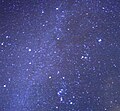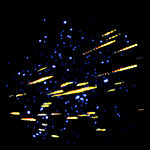獵戶座流星雨
| 獵戶座流星雨 Orionids(ORI) | |
|---|---|
 | |
| 發現日期 | 1839年10月[1] |
| 母體 | 哈雷彗星[2] |
| 輻射點 | |
| 星座 | 獵戶座(靠近 參宿四) |
| 赤經 | 06h 24m[2] |
| 赤緯 | +15°[2] |
| 性質 | |
| 出現時期 | 10月16日至27日[2] |
| 峰值日期 | 10月21日[2] |
| 速度 | 66.9[3] km/s |
| 每小時天頂流星數 | 一般20–25[4] |
| 相關條目:流星雨列表 | |
獵戶座流星雨是發生在10月至11月初的流星雨,高峰期出現在10月21至22日,每小時約可以觀測到60顆來自獵戶座靠近雙子座邊緣輻射點的流星。[5][6]不同於其他的流星雨,獵戶座流星雨在極大期的10月21至22日前後幾天都能夠見到,且來自輻射點的流星每小時大約仍有5至10顆。
歷史[編輯]
在19世紀,流星雨首次被指定為「流星」(shooting stars),並和彗星有關。[7]E·C·赫里克在1839年和1840年對10月夜空中流星的活動進行了觀察。A·赫歇爾製作了第一個關於流星的記錄,並對下一次流星雨做出了準確的預報。[8] 獵戶座流星雨由哈雷彗星產生;該彗星以天文學家愛德蒙·哈雷命名,上次經過內太陽系是在1986年,運轉周期大約為75-76年。[9]當彗星通過太陽系時,太陽升華了其中一些凝固的物質,讓岩石顆粒從彗星中脫離出來。這些顆粒繼續留在彗星的軌跡上,當穿過地球的大氣層時,它們就以流星的形式出現。[7][10]與哈雷彗星有關的另一個流星雨是五月初的寶瓶座η流星雨。[10]
| 年份 | 活動日期範圍 | 高峰日期 | 天頂每時出現率 |
|---|---|---|---|
| 1839 | October 8–15[8] | ||
| 1864 | October 18–20[8] | ||
| 1981 | October 18–21[8] | October 23 | 20 |
| 1984 | October 21–24[8] | October 21–24 | (flat maximum) |
| 2006 | October 2 — November 7[8][11] | October 21–24[11][12] | 23 with peaks at 67 |
| 2007 | October 20–24[13] | October 21 (predicted)[13] | 70[14] |
| 2008 | October 15–29[10] | October 20–22 (predicted)[10] | 39 |
| 2009 | October 18–25 [8] | October 22[15][16][17] | 45[15] |
| 2010 | October 23 | 38 | |
| 2011 | October 22 | 33 | |
| 2012 | October 2 — November 7 | October 20 and October 23 | 43[18] |
| 2013 | October 22 | ~30[19] | |
| 2014 | October 2 — November 7 | October 21 | 20?[20] |
| 2015 | October 2 — November 7 | October 20–21[21] | N/A |
| 2016 | October 2 — November 7 | October 21[22] | ~10–20 |
* 這些流星可能會有雙次高峰期,同樣的和高原,並持續平面最大值長達數天。[8]
流星雨和位置[編輯]

獵戶座流星雨的輻射點位於獵戶座和雙子座之間(中緯度觀察,黎明前在東南方的天空)[23][24]。在2009年,來自英國的電報宣告流星雨做活躍的時間是10月21日凌晨,美國東方標準時間早上6點,或英國的11點[25]。《今日宇宙》報導,流星雨在21日早晨達到巔峰之際的速度是每小時140,000英里(230,000公里),但與往年歷次的流星雨相比,2009年的流星雨軌跡顯得更加狹窄,沒有分支[26]。在美國阿拉巴馬州的太空飛行中心觀測到少量與哈雷彗星相關的流星,從輻射點像四面八方輻射而出的光跡[27]。
圖片集[編輯]
-
一顆獵戶座流星雨的流星
-
魚眼鏡頭拍攝的獵戶座流星雨
-
兩顆獵戶座流星雨的流星和銀河
-
多種顏色的獵戶座流星雨的流星
-
獵戶座流星雨位於左邊
-
最亮的流星,一個火球,留下的煙塵痕跡被高空的風吹離而偏向圖的右手方向
參見[編輯]
參考[編輯]
- ^ Jenniskens, Peter, Meteor Showers And Their Parent Comets, Cambridge University Press: 9, 2006 [2017-10-20], ISBN 0521853494, (原始內容存檔於2019-06-09).
- ^ 2.0 2.1 2.2 2.3 2.4 Moore, Patrick; Rees, Robin, Patrick Moore's Data Book of Astronomy 2nd, Cambridge University Press: 275, 2011 [2017-10-20], ISBN 0-521-89935-4, (原始內容存檔於2020-04-24).
- ^ Kero, J.; et al, First results from the 2009–2010 MU radar head echo observation programme for sporadic and shower meteors: the Orionids 2009, 皇家天文學會月報, October 2011, 416 (4): 2550–2559, Bibcode:2011MNRAS.416.2550K, doi:10.1111/j.1365-2966.2011.19146.x.
- ^ Rendtel, Jürgen, The Orionid meteor shower observed over 70 years, Trigo-Rodríguez, J. M.; Rietmeijer, F. J. M.; Llorca, Jordi; Janches, Diego (編), Advances in Meteoroid and Meteor Science, Springer: 106–109, 2008 [2017-10-20], ISBN 0387784187, (原始內容存檔於2019-06-14).
- ^ IMO Meteor Shower Calendar 2009. The International Meteor Organization. 1997–2009 [2009-10-22]. (原始內容存檔於2010-02-09).
- ^ Orionids Meteor Shower Lights Up the Sky. PhysOrg.com. 2003–2009 [2009-10-21]. (原始內容存檔於2011-11-15).
- ^ 7.0 7.1 Jaggard, Victoria. Orionids Meteor Shower Starts This Weekend. National Geographic News. National Geographic Society. 1996–2009 [2009-10-21]. (原始內容存檔於2017-05-18).
- ^ 8.0 8.1 8.2 8.3 8.4 8.5 8.6 8.7 Orionid. Observing the Orionids. Meteor Showers Online. [2009-10-21]. (原始內容存檔於2017-02-17).
- ^ Phillips, Dr. Tony. NASA – The 2009 Orionid Meteor Shower. NASA. 2009-10-19 [2009-10-19]. (原始內容存檔於2009-10-22).
- ^ 10.0 10.1 10.2 10.3 Orionids Meteor Shower 2008 of October. Meteor. October 15, 2008 [2009-10-21]. (原始內容存檔於2012-02-28).
- ^ 11.0 11.1 October to December 2006. The International Meteor Organization –. 1997–2007 [2009-10-22]. (原始內容存檔於2009-11-02).
- ^ Stone, Wes. 2006 Orionid Meteor Shower Surprise! (PDF). Sky tour. [2009-10-22]. (原始內容存檔 (PDF)於2016-08-23).
- ^ 13.0 13.1 Handwerk, Brian. "Old Faithful" Orionid Meteor Shower Peaks This Weekend. r National Geographic News. October 17, 2009 [2009-10-22]. (原始內容存檔於2017-10-20).
- ^ Orionids 2007: visual data quicklook. imo.net
- ^ 15.0 15.1 Orionids 2009. imo.net
- ^ Jaggard, Victoria. 2009 Orionid Meteor Shower Peak Begins. National Geographic News. October 20, 2009 [2009-10-20]. (原始內容存檔於2016-11-30).
- ^ French, John. Abrams Planetarium Night Sky Notes. [2009-10-21]. (原始內容存檔於2018-11-01).
- ^ Orionids 2012: visual data quicklook. imo.net
- ^ 2013 Orionids Radio results. RMOB. [2014-08-13]. (原始內容存檔於2018-08-19).
- ^ Meteor Shower Calendar | IMO | Page 2014. IMO. 2014-06-20 [2017-10-16]. (原始內容存檔於2015-09-04).
- ^ 2017 Orionid Meteor Shower. Timeanddate.com. [2017-10-16]. (原始內容存檔於2021-02-09).
- ^ Look for Orionid meteors this month | Astronomy Essentials. EarthSky. [2017-10-16]. (原始內容存檔於2021-03-07).
- ^ Observing the Orionids. Meteor Showers Online. [2009-10-19]. (原始內容存檔於2018-07-11).
- ^ Okanagan Observatory's Notes. Okanagan Observatory. 2009 [2009-10-21]. (原始內容存檔於2020-07-12).
- ^ Collins, Nick. Meteor shower: Orionids reach peak The Orionid meteor shower, a trail of debris left in space by Halley's Comet, was at its most intense in the early hours of Wednesday.. Telegraph.co.uk. Telegraph Media Group Limited. October 21, 2009 [2009-10-21]. (原始內容存檔於2012-11-12).
- ^ Piotner, Tammy. The Orionid Meteor Shower – What Did You See?. Universe Today. 2009-10-21 [2009-10-21]. (原始內容存檔於October 24, 2009).
- ^ SpaceWeather.com – News and information about meteor showers, solar flares, auroras, and near-Earth asteroids. Meteor Shower Update: The Orionid meteor shower is subsiding. Spaceweather.com. [2009-10-22]. (原始內容存檔於2010-08-04).
外部連結[編輯]
- 2016年獵戶座流星雨世界各地觀看時間 (頁面存檔備份,存於互聯網檔案館)
- 本周獵戶座流星雨高峰期 (頁面存檔備份,存於互聯網檔案館)
- 2012年獵戶座流星雨(國際流星組織)
- Spaceweather.com上的2009年獵戶座流星雨照片集 (頁面存檔備份,存於互聯網檔案館)
- realclearwx.com: 2009年獵戶座流星雨照片和視頻
- Constellation Guide上的獵戶座流星雨 (頁面存檔備份,存於互聯網檔案館)
| ||||||||||||||||||||||||||||||||||||||||||||||||||||||||||||||||||||||||||||||||||||||||








